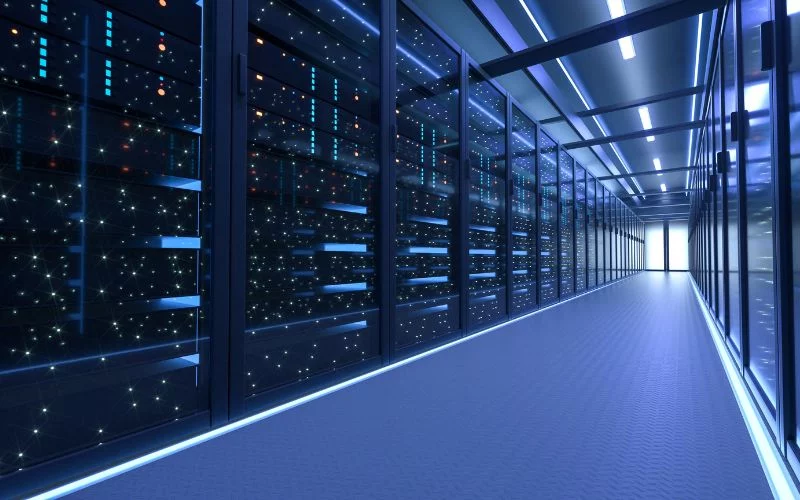Imagine a world without data centers — websites would go offline, cloud services would fail, and businesses would struggle to store and manage their growing volumes of data. Behind the seamless digital experience we all rely on, data centers are the hard infrastructure of the Internet as we know it. These highly specialized facilities house the servers, storage, and networking equipment needed to power everything from emails to complex AI models. Building a data center, however, is a complex and multi-faceted process that requires careful planning, technical expertise, and significant investment.
In this guide, we’ll explore the evolution of data center construction, dive into the site selection process, take you through the construction steps, and examine various methodologies and strategies used today. Whether you’re planning to build a data center or simply want to understand the process, this article provides a comprehensive overview.
Here’s a table summarizing the Data Center Construction Process, Site Selection, Methodologies and Strategies, and Costs discussed in your provided guide:
| Category | Subcategory | Description | Impact/Consideration |
|---|---|---|---|
| 1. Evolution & Expansion of Data Center Construction | Early Days | Initially, small, localized facilities for mainframes and basic network infrastructure. Focus on power supply, cooling, and security. | Limited infrastructure and smaller scale, focusing on essential needs. |
| Modern Era | Data centers now need to handle high-density computing, cloud services, AI, IoT, and scalable solutions. Energy efficiency and sustainability are prioritized. | Larger scale, sophisticated technology, scalability, and energy management are central. | |
| Edge Computing | Data centers are now designed closer to users to reduce latency and improve performance. | Reduced latency for better user experiences, especially in IoT and real-time applications. | |
| 2. Data Center Site Selection | Geography & Climate | Cooler climates are preferred to reduce cooling energy consumption. Areas prone to natural disasters (earthquakes, floods) are avoided. | Lower operational costs, energy efficiency, and reduced risks of natural disasters. |
| Proximity to Network Infrastructure | Sites near fiber-optic cables and communication hubs provide fast, reliable connectivity. | Better network performance, low latency, and high bandwidth. | |
| Power Availability & Cost | Reliable, affordable access to power is crucial. Renewable energy sources (solar, wind) may be prioritized to reduce costs and environmental impact. | Cost-effective power, reduced environmental footprint, and reliable energy supply. | |
| Regulatory Environment | Local laws and regulations on data privacy, construction, and environmental regulations must be considered. | Compliance with legal requirements and sustainability regulations. | |
| 3. Pre-Construction Preparations | Designing the Layout | Floor planning is critical for organizing equipment, ensuring efficiency, and allowing for future growth. Architects and engineers design for scalability. | Efficient space management and future flexibility for scaling operations. |
| Permitting & Approvals | Necessary permits include zoning, safety certifications, and environmental impact assessments. | Ensures legal compliance and environmental sustainability before construction begins. | |
| Budgeting & Resource Allocation | Accurate budget planning to ensure the project remains within scope. Resource allocation is critical to manage the complex nature of building a data center. | Prevents cost overruns and ensures proper use of resources, including labor and equipment. | |
| Vendor Selection | Choosing the right contractors and equipment vendors ensures the use of high-quality materials and up-to-date technologies. | Quality of vendors impacts construction speed, quality, and operational longevity. | |
| 4. Data Center Construction Process | Site Preparation | Land clearing, excavation, and laying of the foundation, plus the installation of power, water supply, and cooling systems. | Prepares the physical infrastructure to support the data center. |
| Building the Structure | Constructing the building using durable materials (steel, reinforced concrete) to withstand environmental stresses. | Strong physical infrastructure ensures safety and longevity. | |
| Infrastructure Installation | Key systems like PDUs, cooling, networking, electrical, and HVAC systems are installed. | Ensures operational reliability and energy efficiency. | |
| Security Systems | Surveillance cameras, access control, and biometric scanners are installed for physical security. | Provides safety for both equipment and data stored within the data center. | |
| Final Testing & Commissioning | Extensive testing of power systems, cooling, network connectivity, and security before the data center is fully operational. | Validates that the facility meets performance standards before operation begins. | |
| 5. Data Center Construction Methodologies & Strategies | Traditional Data Centers | Custom-built facilities tailored to the organization’s specific needs, often taking longer and costing more. | Provides complete control and customization, but with higher costs and longer build time. |
| Modular Data Centers | Pre-fabricated, easily assembled units that allow for quicker deployment and scalability. | Ideal for businesses needing rapid expansion with cost-effective solutions. | |
| Cloud-Optimized Data Centers | Built specifically for cloud providers, these centers emphasize energy efficiency, high-density computing, and scalability. | Perfect for cloud service providers needing high performance and scalability. | |
| Edge Data Centers | Smaller data centers located near end users to reduce latency and improve performance, especially for IoT and real-time applications. | Improves performance and reduces latency for cloud services, content delivery, and IoT. | |
| 6. Cost to Build a Data Center | Land Acquisition | The cost of purchasing or leasing land for the data center location. | Land prices vary by region, impacting overall budget. |
| Construction Materials | The cost of steel, reinforced concrete, and specialized electrical systems required to build the data center structure. | Affects initial construction costs, especially in areas with high material prices. | |
| Technology & Equipment | Cost of servers, networking gear, cooling systems, and security infrastructure. | Significant portion of the overall investment, depending on the equipment chosen. | |
| Labor & Expertise | Skilled labor, including engineers, architects, and project managers, are required for the construction and setup of the data center. | Labor costs and expertise ensure quality construction and proper setup. | |
| Average Costs | A mid-sized data center typically costs $10 million to $50 million to build, with large-scale facilities potentially exceeding this amount. | High upfront costs but essential for scalability, efficiency, and data management. | |
| 7. Key Cost Drivers | Land Acquisition | Location of the data center (urban vs. rural) heavily influences land cost. | More expensive in urban areas, while rural areas offer cheaper land but may face other challenges (e.g., energy). |
| Construction Materials | Quality of materials like steel and reinforced concrete, required for structural integrity. | Higher material quality leads to more durable data centers, but with higher initial costs. | |
| Technology & Equipment | Investment in state-of-the-art servers, networking hardware, and cooling technologies. | Advanced technology ensures performance and scalability but increases costs. | |
| Labor Costs & Expertise | The need for specialized labor and experts adds to construction costs. | Essential for quality construction and operational success, but labor costs vary by region and complexity. |
Evolution and Expansion of Data Center Construction Process
It’s interesting to know that the construction of data centers has come a long way since the early days of computing. Initially, data centers were small, localized facilities designed to house a few mainframes and critical network infrastructure. These early centers were designed with basic infrastructure, focusing on reliable power supply, cooling, and basic security. However, as data usage exploded and the digital transformation accelerated, data center requirements grew exponentially.
Today, data centers are massive, sophisticated operations that need to support the growing demand for data storage, processing, and networking. The evolution of cloud computing, artificial intelligence, and the Internet of Things (IoT) has driven this shift. Modern data centers are designed to be scalable, efficient, and capable of handling high-density computing, making energy efficiency and sustainable practices central to the construction process.
In addition, the growing trend toward edge computing has influenced how data centers are built and deployed. Edge data centers, located closer to end users, are designed to reduce latency and improve performance. As technology continues to evolve, so too does the design and construction of data centers, with a focus on flexibility, speed, and resilience.
Read more: What Is Data Center Networking?
Data Center Site Selection
Choosing the right site for a data center is one of the most critical decisions in the construction process. A poor location can lead to issues like unreliable power, limited connectivity, or high operational costs. Several factors must be taken into account during site selection:
- Geography and Climate: Location plays a significant role in determining energy efficiency. Cooler climates are often preferred as they reduce the need for energy-intensive cooling systems. Similarly, areas prone to natural disasters, such as earthquakes or floods, should be avoided.
- Proximity to Network Infrastructure: Data centers need fast, reliable connectivity to function properly. Sites near fiber-optic cables and major communication hubs are preferred.
- Power Availability and Cost: Data centers are energy-hungry facilities, so having access to a reliable and affordable power grid is crucial. In some cases, renewable energy sources, such as solar or wind power, may be prioritized to reduce operational costs and environmental impact.
- Regulatory Environment: Local laws and regulations must also be considered. Different regions have different rules regarding data privacy, construction codes, and environmental regulations.
Choosing the right site is a balancing act between technical needs, environmental considerations, and economic factors.
Pre-Construction Preparations
Before breaking ground on a data center, careful planning and preparation are essential. This phase includes several important steps:
-
Designing the Layout
The floor plan for the data center design is crucial, as it will determine how equipment is organized, how cooling systems are laid out, and how much space is available for future growth. Architects and engineers collaborate closely to ensure optimal layout for efficiency and scalability.
Read more: What is Data Center Architecture?
-
Permitting and Approvals
Obtaining the necessary permits is a critical step in the pre-construction process. This includes environmental impact assessments, zoning permits, and safety certifications.
-
Budgeting and Resource Allocation
Building a data center is expensive, with costs often reaching millions of dollars. Accurate budgeting and resource allocation are essential for ensuring that the project remains on track and within scope.
-
Vendor Selection
Choosing the right construction contractors and equipment vendors is another critical part of the pre-construction process. This ensures that the data center is built with high-quality materials and up-to-date technologies.
This stage sets the foundation for the entire project, so it’s essential to get it right.
Data Center Construction Process
Once the planning is in place, the actual construction of the data center can begin. The process typically follows these key stages:
-
Site Preparation
The land is cleared, and the foundation is laid. This includes excavation, leveling, and the installation of essential infrastructure like power lines, water supply, and cooling systems.
-
Building the Structure
The main building is constructed with specialized materials designed to withstand environmental stresses and ensure the safety of the equipment inside. Steel and reinforced concrete are often used due to their durability.
-
Infrastructure Installation
This phase involves the installation of key systems, including power distribution units (PDUs), cooling systems, and networking infrastructure. Electrical and HVAC (heating, ventilation, and air conditioning) systems are also installed to maintain optimal operating conditions.
-
Security Systems
Physical security is a top priority for data centers. Surveillance cameras, access control systems, and biometric scanners are installed to ensure the safety of both the facility and the data stored within.
-
Final Testing and Commissioning
Once the construction is completed, the facility undergoes extensive testing to ensure everything operates as expected. This includes testing power systems, cooling efficiency, network connectivity, and security protocols.
At this point, the data center is ready to house servers and other critical infrastructure.
Data Center Construction Methodologies and Strategies
There are different methodologies and strategies used in data center construction, each with its advantages:
- Traditional Data Centers: These facilities are often custom-built to meet the specific needs of an organization. They typically involve a longer construction time and higher costs but offer a high level of control and customization.
- Modular Data Centers: These pre-fabricated units can be quickly assembled on-site, allowing for faster deployment and scalability. Modular data centers are increasingly popular for businesses that need to scale quickly.
- Cloud-Optimized Data Centers: These data centers are designed with the specific needs of cloud providers in mind, focusing on energy efficiency, high-density computing, and seamless scalability.
- Edge Data Centers: Located closer to end-users, these smaller data centers reduce latency and improve performance for cloud services, IoT devices, and content delivery networks.
Each approach offers different benefits depending on the organization’s needs, budget, and goals.
Cost to Build a Data Center
The cost of building a data center varies greatly depending on its size, location, and technology. On average, the cost of constructing a mid-sized data center can range from $10 million to $50 million, though some high-end facilities may exceed this. Key cost drivers include:
- Land Acquisition: The cost of purchasing or leasing the land for the facility.
- Construction Materials: The price of high-quality materials such as steel, reinforced concrete, and specialized electrical systems.
- Technology and Equipment: The cost of servers, networking gear, cooling systems, and security infrastructure.
- Labor and Expertise: Skilled labor and the expertise of engineers, architects, and project managers are essential for a successful data center build.
While the initial costs are high, the long-term benefits — such as enhanced data storage, high uptime, and scalability — make data centers a vital investment for businesses and data center service providers.
Read more: Steps for Effective Data Center Capacity Planning
Final Thoughts
Building a data center is a complex, multi-phase project that requires meticulous planning, significant financial investment, and the collaboration of various experts. From site selection and pre-construction preparations to construction and final testing, each step is essential to creating a functional, reliable, and secure data center. The process continues to evolve with the growth of new technologies like cloud computing and edge data centers, making it an exciting and ever-changing field. As data demand grows globally, the importance of well-built data centers will only continue to increase.
FAQ
What is the typical timeline for constructing a data center?
The timeline for building a data center varies depending on size and complexity. On average, a mid-sized facility takes 18-24 months, including planning, permitting, construction, and commissioning. Modular designs can reduce this timeframe significantly.
How does site selection impact data center performance?
Site selection affects energy efficiency, connectivity, and disaster resilience. Locations with stable climates, low energy costs, and proximity to network hubs are preferred. Poor choices may increase operational costs and reduce reliability.
What are modular data centers, and why are they popular?
Modular data centers are pre-fabricated units assembled on-site. They are popular for their fast deployment, scalability, and cost-effectiveness, making them ideal for businesses needing to expand quickly or in remote locations.


